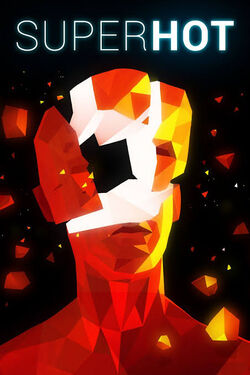| Superhot | |

| |
| Developer(s) | Superhot Team |
|---|---|
| Publisher(s) | Superhot Team |
| Release Date(s) | Xbox One May 3, 2016 Windows, OS X February 25, 2016 |
| Genre(s) | First-person shooter |
| Mode(s) | Single-player |
| Platform(s) | Xbox One, PlayStation 4, Windows, Oculus Quest, OS X, Linux |
| “ | The FPS where time moves only when you move | ” |
—Slogan used for promotion of game | ||
Superhot is an independent first-person shooter video game developed and published by Superhot Team. Though the game follows traditional first-person shooter gameplay mechanics, with the player attempting to take out enemy targets using guns and other weapons, time within the game progresses only when the player moves; this creates the opportunity for the player to assess their situation and respond appropriately, making the gameplay similar to strategy video games.
Gameplay
In Superhot, time moves slower when the player doesn’t move. The game moves faster when they look around or move,giving them situational awareness to respond to enemy actions, such as altering their course to avoid the path of oncoming bullets. The game uses a limited palette of colors - whites, blacks, and reds - to aid the player in focusing on key elements.
Plot
The Superhot narrative works in several metanarrative levels: the player plays a fictionalized version of themselves sitting in front of their DOS prompt, getting a message from their friend who offers them a supposedly leaked copy of a new game called superhot.exe, claiming that the only way to access it is with a crack. Launching the game immediately thrusts the player into a series of seemingly unconnected levels via different points of view, all based around killing hostiles, after which the game glitches out and disconnects. After this crash, the player's friend sends an updated version of the .exe file, apparently a new version of the game that fixes the "glitches".
As both the player and their friend play through superhot.exe, it becomes apparent that the player's presence in the game is monitored by whoever is responsible for the game - referring to itself as a "system" - and demands they cease playing via various methods, such as ominous threats showing the player's in-game residence, and altering the player's messages to their friend to urge them to stop playing, eventually harassing the player's friend into giving up on the game and engineering a fallout with them. As the player goes through more and more levels, each apparently targeting specific locales, the system's warnings grow more ominous, telling them the player is unaware of the consequences of their actions, eventually forcing the player to walk to their own in-game house and to their in-game player character, a figure wearing VR headgear, and punch themselves into unconsciousness. Upon doing so, the "game" glitches out, and the player character wakes with a severe head injury. Afterward, the system warns the player once again to stop using Superhot, and forces the player to quit the game entirely.
Inevitably, the player will start up Superhot again, and the system concedes to the player's insistence to keep playing, fully encouraging them to play more and more. Now under the system's sway, the player begins a rampage through city streets, cutting through enemies to get closer and closer to a massive laboratory that houses the system itself. There, it guides the player into uploading itself into the core as numerous enemies attempt to stop the player. Once done, the player becomes part of the core, joining numerous other minds absorbed by the core itself into a transhuman hivemind. The core forces the player to shoot their original body/player character, finally making them one with Superhot.
Reception
The Xbox One version of the game received a 83/100 on Metacritic.